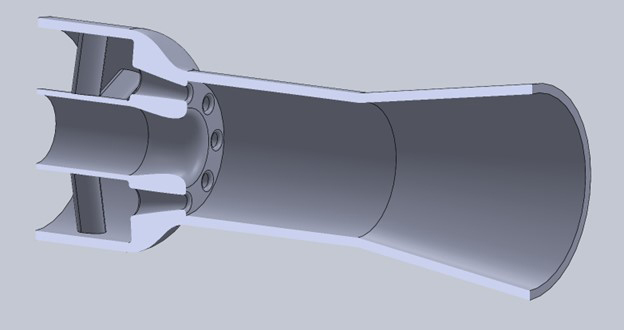Background
The project was undertaken to address a critical gap in the field of hypersonic vehicle development, particularly for air-breathing propulsion systems such as scramjets. As the defense industry shifts focus towards developing reusable and long-duration hypersonic vehicles, there has been a growing need for advanced thermal management and onboard power generation solutions. Current systems are limited by fuel-based cooling approaches that either risk overheating due to hydrogen boiling or suffer from coking issues associated with liquid hydrocarbons. Moreover, in the absence of gas turbine engines these vehicles are heavily reliant on batteries for onboard power, which is not viable for long-term missions. The project is investigating the feasibility of employing a supercritical CO2 (sCO2) heat exchanger for both cooling scramjet walls and concomitant power generation. By leveraging sCO2's unique thermophysical properties, the project seeks to advance the state of the art in regenerative cooling, thereby meeting a pressing demand identified by the Department of Defense and facilitating the development of more robust and efficient hypersonic technologies.
Approach
The objective of the project is to design, build, and test a proof-of-concept supercritical CO2 (sCO2) heat exchanger for onboard cooling and power generation in scramjet systems. Currently, the design and fabrication of a bespoke ejector system for the test facility is being undertaken to create a low-pressure environment downstream of the test section to simulate high-altitude conditions. Concurrently, the project team is designing the sCO2 heat exchanger. The approach includes involving analytical and numerical modeling to optimize heat transfer efficiency while minimizing weight and size constraints. A key challenge is balancing the need for efficient heat transfer while keeping wall thicknesses large enough to contain the high-pressure sCO2. Once the ejector and heat exchanger are finalized and fabricated, the commissioning phase will involve installing the bypass piping and ejector, updating control software, and conducting a series of tests to ensure proper ejector performance and flow uniformity. The final phase integrates the heat exchanger into the test facility, followed by comprehensive testing to characterize its performance across a range of operating conditions, simulating a scramjet flight trajectory. The anticipated results are expected to establish the feasibility of using sCO2 technology for scramjet cooling and onboard power generation.
Accomplishments
The project was recently initiated. Ejector and heat exchanger designs are nearing completion, with fabrication expected in the coming months.

Figure 1: Cross-section of a notional ejector design. Flow is left to right. The center channel is the exhaust from the scramjet. The outer nozzles are designed to create a low-pressure environment to simulate high altitude.

